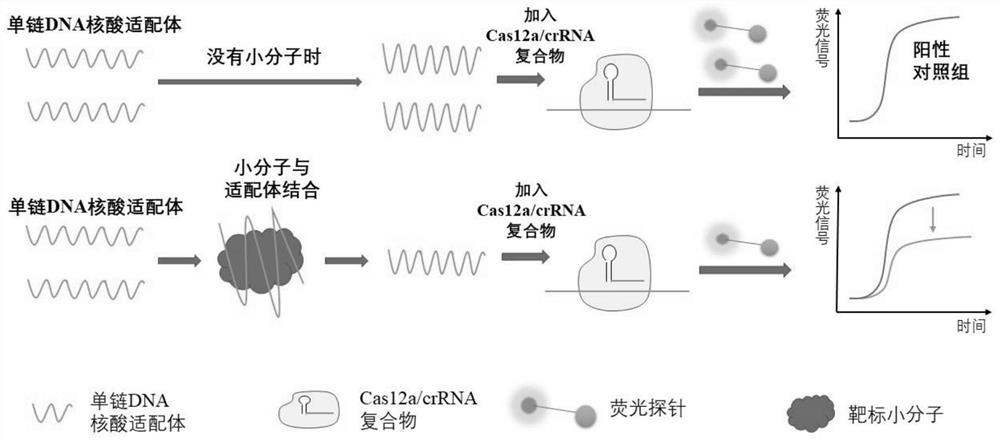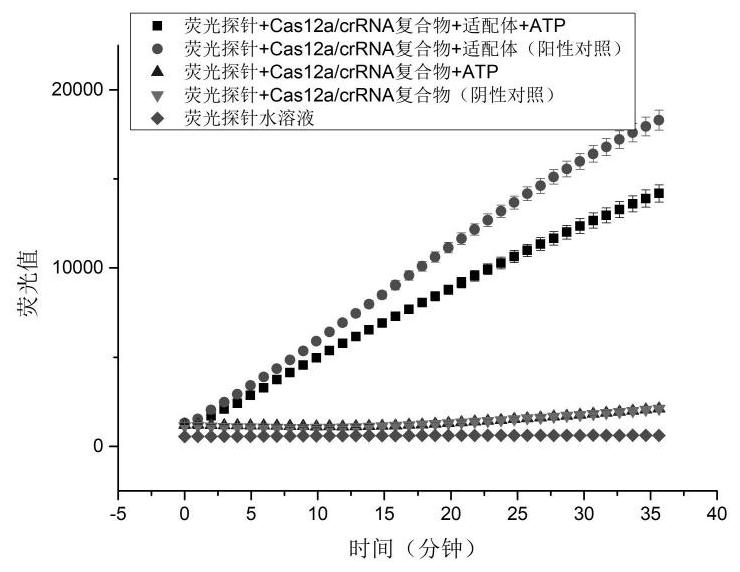Method for detecting concentration of target molecule in mixed systemand kit
A target and molecular technology, applied in the field of a method and kit for detecting the concentration of target molecules in a mixed system, can solve the problems of large limitations and achieve the effect of short time consumption and simple operation
- Summary
- Abstract
- Description
- Claims
- Application Information
AI Technical Summary
Problems solved by technology
Method used
Image
Examples
Embodiment 1
[0072] Example 1 Feasibility Verification Experiment
[0073]In order to verify the feasibility of the method, we chose ATP's adapter sequence (SEQ ID NO.1), and designed CrRNA-ATP sequences according to this sequence, combined with the characteristics and properties of Cas12a nuclease and its crrna ( SEQ IDNO.2). Positive control (PC, curve with a circular point) By forming a Cas12A-CrNA-adapter composite, CAS12A is activated, and the FQ Probe is cut by inverted active, and the other is added to the other group. The molecule acts as an experimental group (curve of the ribbon), due to the specific binding of the adapter, resulting in the effective adapter of the excitation, and the fluorescence value decreases (see Figure 2A ).
[0074] Considering the decline in the addition of ATP, it is possible to have such a target molecule that has an effect on the activity of the protein in the reaction system, thereby reducing the fluorescent signal, is not an inhibitory effect that the co...
Embodiment 2
[0098] Example 2. Optimization of the reaction system
[0099] 1 Optimization of the reaction buffer system:
[0100] Cas12a is a nuclease, and its cutting activity will definitely be affected by the surrounding environment. In the previous report, some people have used NEB buffer 2.1, NEB buffer 3.1, NEB buffer 4, Neb cutsmart buffer, or buffer itself. Therefore, we have studied the effects of buffer of different ingredients for CAS12A cutting activity (see Figure 3A with Figure 3B ). It can be seen that important factors affecting Cas12a lysis activity is the divalent cation mg in the test solution. 2+ concentration. Because the Cas12a RUVC domain clears SSDNA, MG by bimetallic ion mechanism 2+ Ions induce the conformational coordination of the RUVC domain and SSDNA by changing the spatial distribution around the SSDNA in the RUVC active cutting center. This result is consistent with the previous report. But when MG 2+ When the concentration is constant, different buffers also e...
Embodiment 3
[0114] Example 3 Sensitivity and specific experiment
[0115] Based on the above optimization conditions, we evaluate the sensitivity of the method to detect the ATP target molecule. We will use the adapter as a SSDNA-activated sub-activator as a positive control. After adding different concentrations of ATP, due to the specific binding of ATP and adapter, it is reduced by the adapter of activation, and the fluorescent signal has different degrees of decline. Figure 8A ). Quantitative analysis can be accomplished by monitoring the inhibition rate after 13 min after the start. We IR% of ATP y-axis, the logarithm of the ATP concentration is plotted as the x-axis, can be obtained by fitting a linear response, R2 = 0.9496, its dynamic range (dynamicrange) is 0.1mM-5mM (see Figure 8B ). According to the formula detection (LOD) = 3 * SD / slope. The LOD of this method can reach 2.66 μm. This sensitivity and dynamic range are better than the adapter-based color sensor, but may not reach ...
PUM
 Login to View More
Login to View More Abstract
Description
Claims
Application Information
 Login to View More
Login to View More - R&D
- Intellectual Property
- Life Sciences
- Materials
- Tech Scout
- Unparalleled Data Quality
- Higher Quality Content
- 60% Fewer Hallucinations
Browse by: Latest US Patents, China's latest patents, Technical Efficacy Thesaurus, Application Domain, Technology Topic, Popular Technical Reports.
© 2025 PatSnap. All rights reserved.Legal|Privacy policy|Modern Slavery Act Transparency Statement|Sitemap|About US| Contact US: help@patsnap.com



